Navcad
-
- Tech File: HydroComp NavCad for Optimized Design Marine News, May 2017 #50
HydroComp NavCad, internationally recognized for resistance and propulsion prediction for naval architects, can also leverage analysis capabilities with features that support optimized hull form and propulsion system design.
NavCad may be most well-known for its library of parametric-statistical hull form and propulsion system models (often called “1D” models). The recent introduction of the Premium Edition now brings a higher-order distributed-analytical (“2D”) hull form analysis to design optimization. Called the Analytical Distributed-Volume Method (ADVM), the scope of design optimization can now offer both a first order assessment and an analytical calculation of a more refined definition of hull form.Parametric-statistical optimizationNavCad’s parametric-statistical (“1D”) optimizing utilities specifically do not identify a singular optimum figure, but rather indicate trends and influences. As many different design requirements influence a vessel’s design and construction, employing a unique hydrodynamic optimum is rarely attainable.Donald MacPherson, HydroComp Technical Director, notes “The Drag Reduction tool provides designers with a meaningful metric to identify changes to the present hull design that will reduce drag and increase performance and efficiency. For example, it offers practical insight into the ‘What if’ questions: What if half angle of entrance is decreased? What if I add a bulb? What if the LCG is shifted aft? Designers and naval architects now have the ability early in the design to rapidly evaluate the influence of various hull parameters on vessel drag, and more importantly, on real operational efficiency.”The resistance curve for the initial design is the “basis” resistance. The Drag Reduction analysis then evaluates the influence on resistance of the change in various hull parameters – length, displacement, LCB, even transom immersion, for example. The hull parameters are then organized by influence, with the most significant parameter presented at the top of the table.It is also important to consider not only the hydrodynamic influences of the parameters at the design speed, but also across the operating speed range. For example, transom immersion may be beneficial at high speed, but detrimental at lower speeds. In order to consider the influences on overall operation, NavCad’s drag reduction analysis allows the user to enter primary and secondary operating profiles using speed and time-at-speed. A “Total energy” weighted influence is calculated based on these user-defined primary and secondary operating profiles. This total energy approach allows NavCad to evaluate the effect of a hull parameter on the change of overall energy consumption of the vessel.MacPherson continues, “By knowing the general hydrodynamic influences and trends as suggested by these tools, a designer can improve and optimize hydrodynamic performance in a way that does not compromise other design constraints, such as stability, structure, loading, or producibility. It is extremely valuable for a naval architect to simply know which direction to push a parameter when juggling the various – and often competing – design requirements.”In a similar fashion, NavCad can evaluate the effect that vessel loading and initial trim can have on operational performance. NavCad’s Effect of initial trim utility provides useful information to designers and operators alike. In an effort to reduce fuel consumption, ship operators are often interested in the effect of initial trim on the performance of the vessel. This supplemental tool will provide an essential assessment of the effect of initial trim on bare-hull resistance for ships large and small.Distributed-analytical optimizationThe Analytical Distributed-Volume Method (ADVM) module is a bare-hull resistance prediction method that can be used to supplement a parametric-statistical method. Inspired by analytical wave-making theory, it is a prediction of ship resistance where the hull form is described by the longitudinal distribution of the immersed volume and not by parameters. Calculation of wave-making and viscous drag, including a careful prediction of form factor and frictional drag coefficients, completes the computation of total bare-hull resistance. HydroComp’s design mission for the module was to provide a method that was:- computationally efficient,
- reliably predicted total resistance,
- was uniformly consistent and well-behaved, and
- required no extensive training in the methodology.
Due to its basis in the distribution of the immersed volume rather than its 3D wetted surface (such as is used by CFD), the definition of the hull is fully descriptive of significant shape characteristics for the purposes of optimized design. For example, where a parametric-statistical model may be limited by the nature of a parent hull form, the ADVM analysis allows any description of sectional area curve, waterplane distribution, transom immersion, entrance and run shapes.Extensive validation studies were conducted by HydroComp for the development of the ADVM module. It is both quantitatively reliable in the prediction of resistance and qualitatively functional for comparison of design variants.NavCad Premium includes features that allow the ADVM method to be run as a coupled solver, including a batch or macro scripting API for data and processes, and quiet mode operation without the GUI (server mode). NavCad can be coupled with third-party software such as Excel or Matlab, as well as optimizing-purposed tools like CAESES. The NavCad coupled solver process is simple and computationally very efficient.Example optimized designsThe use of NavCad for optimized design can be for the “whole system” or a “component”. Recent published studies of “whole system” optimized design with NavCad include an AUV, waterjet-driven patrol boat, and a motor yacht. A very successful “component” optimized design study was for a bulbous bow retrofit.System optimizationsA variety of optimized designs have been conducted using NavCad coupled with the CAESES software as the executive third-party tool for the management of the geometry and optimization processes. NavCad is the simulation solver responsible for all resistance and propulsion predictions.An AUV system optimization project highlighted a parametric-statistical optimization using NavCad’s Submarine/SWATH prediction methods. The hull was described as a body-of-revolution shape with three zones – fore, mid, and aft (as shown in the graphic below). The design objective was minimum shaft power, with NavCad conducting a component optimization of the propeller at each design step. An analysis of 64 variants was conducted in less than six minutes on a general-purpose business computer.Two surface vessel projects conducted with NavCad as a coupled solver were for a waterjet-driven patrol craft and a planing motor yacht. The patrol craft used the ADVM method for resistance prediction, with an equilibrium force-moment planing solution employed for the motor yacht study. The patrol craft reviewed more than 500 variants at less than two minutes per variant, optimizing for a minimum weighted resistance-weight ratio (Telfer coefficient).Hull form component optimizationWhile NavCad’s strength is in its systems engineering solutions, it is also a very powerful analysis tool for hull form component optimization. NavCad was coupled with Excel for the optimized design of a bulbous bow retrofit on a research vessel. The ADVM distributed-analytical model was used for the calculation of resistance as the volumetric shape was modified with different bulb geometries. Microsoft Excel handled the creation of the modified data and the calculation management with NavCad operating in its quiet “server mode”. A weighted total energy objective was used to determine the best combination of design parameters for the new bulb – leading to substantial reduction in fuel rate and an increase in operational top speed.(As published in the May 2017 edition of Marine News) -
- HydroComp Offers New Ship Propulsion Design Software Maritime Reporter, Oct 1989 #6
Since 1984, marine professionals worldwide have chosen NavCad software as one of their principal design tools for the analysis and selection of engine, gear and propeller systems. HydroComp, Inc., Durham, N.H., has produced NavCad 2.0—the most powerful NavCad software to date. The PC.-based NavCad
-
- HydroComp NavCad: New Submarine SWATH Capabilities Marine Technology, Jan 2013 #56
HydroComp NavCad is a software tool for the prediction and analysis of vessel speed and power performance. It also provides for the selection of suitable propulsion system components – engines, gears and propellers. A recent development effort has been undertaken to provide new submarine and SWATH performanc
-
- HydroComp NavCad Premium Released Marine News, Apr 2015 #55
HydroComp NavCad has been the gold-standard for resistance and propulsion prediction for nearly three decades. Now, an upgrade is available, offered as an optional “Premium Edition” upgrade, and these special new capabilities are a significant addition to the existing hydrodynamic analysis features in the
-
- NavCad V 4 . 0 Released Maritime Reporter, May 2001 #35
HydroComp, Inc. of Durham, N.H. released NavCad v4.0. — a software tool for the prediction and analysis ol" vessel speed and power performance. In terms of looks-and-feel, it is a comfortable transition, the interface is virtually identical to version 3. Regarding the functionality of the program
-
- Using HydroComp NavCad Maritime Reporter, Aug 2014 #112
To resolve static thrust problems on wind farm service vessels HydroComp NavCad is software for resistance and propulsion that can be found in the toolbox of hundreds of naval architects and marine professionals from around the world. The latest challenge for NavCad is to help resolve a unique problem for
-
- MN100: HydroComp, Inc. Marine News, Aug 2016 #34
, Inc. was established in 1984 to provide powering analysis services to naval architects and shipbuilders. Best known for its award-winning NavCad software, HydroComp is regarded as the premier source for performance prediction software, consulting, and knowledge. The firm’s offerings include
-
- HydroComp, HSVA GmbH Announce Alliance Maritime Reporter, Sep 1994 #37
comprehensive source for performance prediction solutions through the mutual representation of products and services. HydroComp, Inc., known for its NavCad resistance and propulsion software, is a leader in applied hydrodynamics for early-stage design. It is supplying HSVA with advanced copies of the
-
- HydroComp Develops Naval Engineering Software Programs Maritime Reporter, Nov 1985 #109
few firms in the country offering software programs designed specifically for naval engineering applications. To meet the demand, Hydrocomp now offers NAVCAD—naval architectural computer-aided design software. HydroComp's programs take standard engineering calculations and package them into a format that
-
- Engineering Better Propulsion Marine Technology, Sep 2018 #54
by viscous and frictional issues, so manufacturing tolerances have to be tighter.”The company’s flagship resistance and propulsion analysis software, NavCad, aids in the sizing and selection of an appropriate thruster or propeller. The software can estimate vehicle drag and quantify the impact on propulsion
-
- Underwater Vehicle Propulsion Tech: Tail Shape and Vehicle-Propulsor Performance Marine Technology, Jul 2020 #16
.Calculation methods and design toolsPrediction of thrust deduction for body-of-revolution UV vehicles is being addressed by new capabilities in HydroComp’s NavCad® software. A new development initiative to better support UV designers started with an update for the data definition of nose, mid, and tail geometries
-
- New Technology To Debut At Europort Maritime Reporter, Oct 2001 #44B
Inc. (also represented by Design Systems & Technologies) will show visitors the latest updates to its suite of advanced design programs, including NavCad, PropExpert and PropCad. NavCad allows personal development of custom solutions within a variety of programming environments. Radio Holland Marine
-
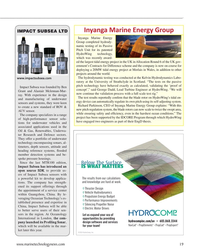 )
September 2024 - Marine Technology Reporter page: 19
)
September 2024 - Marine Technology Reporter page: 19, the com- opportunities by providing hydrocompinc.com/uv • 603.868.3344 pany launched its Pro? ling Sonar, design software and services ® ® ® ® NavCad • PropElements • PropCad • PropExpert for your team! which will be available in the mar- ket later this year. ©2024 HydroComp, Inc. www.marinetechnology
-
 )
September 2024 - Marine Technology Reporter page: 16
)
September 2024 - Marine Technology Reporter page: 16been augmented to generate offsets and erational Energy Analysis, and Propulsion System Sizing. 3D geometry for CAD export. New prediction models now NavCad, and its companion for optimized propulsor design, support vehicles with higher speeds and operation at a pitch PropElements, have become the suite-of-cho
-
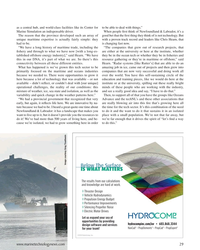 )
July 2024 - Marine Technology Reporter page: 29
)
July 2024 - Marine Technology Reporter page: 29Motor Drives Let us expand your sea of opportunities by providing hydrocompinc.com/uv • 603.868.3344 design software and services ® ® ® ® NavCad • PropElements • PropCad • PropExpert for your team! ©2024 HydroComp, Inc. www.marinetechnologynews.com 29 MTR #5 (18-33).indd 29 7/23/2024
-
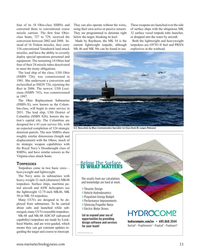 )
January 2024 - Marine Technology Reporter page: 33
)
January 2024 - Marine Technology Reporter page: 33torpedoes are made by Lock- hydrocompinc.com/uv • 603.868.3344 design software and services heed Martin, and are wire-guided, which ® ® ® ® NavCad • PropElements • PropCad • PropExpert for your team! means they can get constant updates re- garding the target and course to intercept. ©2024
-
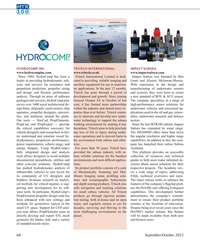 )
September 2023 - Marine Technology Reporter page: 68
)
September 2023 - Marine Technology Reporter page: 68the oil and gas, renew- ties, and militaries around the globe. ues to innovate and develop new under- ables, underwater research and defense Our tools — NavCad, PropElements, water technology to support the subsea sectors. PropCad, and PropExpert — provide working environment by making it less Since the
-
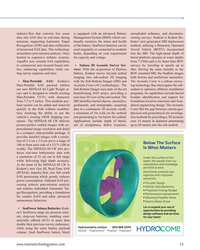 )
September 2023 - Marine Technology Reporter page: 33
)
September 2023 - Marine Technology Reporter page: 33offered AUVs to more than double their previous survey endurance, hydrocompinc.com/uv 603.868.3344• while using the same battery payload ® ® ® ® NavCad PropElements PropCad PropExpert• • • volume. Each SeaPower battery block www.marinetechnologynews.com 33 MTR #7 (18-33).indd 33 10/2/2023
-
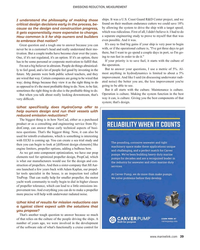 )
August 2023 - Maritime Reporter and Engineering News page: 39
)
August 2023 - Maritime Reporter and Engineering News page: 39design. What speci? cally does HydroComp offer to help owners design and run their vessels with reduced emission reductions? The biggest thing is in how NavCad, either as a purchased product or as a consulting and engineering service from Hy- droComp, can answer those early technical aspects of busi- ness
-
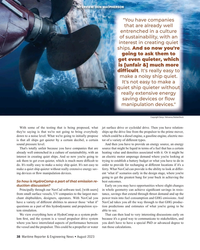 )
August 2023 - Maritime Reporter and Engineering News page: 38
)
August 2023 - Maritime Reporter and Engineering News page: 38not easy to order to provide for recharging at different locations if it's a make a quiet ship quieter without really extensive energy sav- ferry. What NavCad can provide is the ability to look at differ- ing devices or ? ow manipulation devices. ent ‘what if’ scenarios early in the design stage, where
-
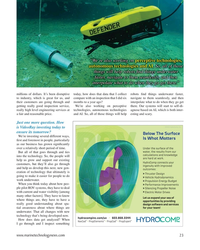 )
July 2023 - Marine Technology Reporter page: 23
)
July 2023 - Marine Technology Reporter page: 23. That all changes with new technology that’s being developed now. hydrocompinc.com/uv 603.868.3344• How does data get analyzed? When ® ® ® ® NavCad PropElements PropCad PropExpert• • • I go through and I inspect something www.marinetechnologynews.com 23 MTR #5 (18-33).indd 23 7/20/2023
-
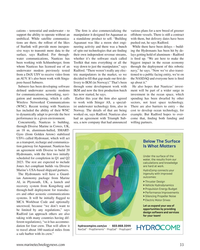 )
January 2023 - Marine Technology Reporter page: 33
)
January 2023 - Marine Technology Reporter page: 33countries having dif- ferent regulations), “so it has accommo- dation for four crew. That will allow it hydrocompinc.com/uv 603.868.3344• ® ® ® ® NavCad PropElements PropCad PropExpert• • • to travel about 160 nautical miles from a safe harbor with its crew.” www.marinetechnologynews.com
-
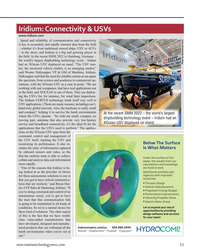 )
September 2022 - Marine Technology Reporter page: 33
)
September 2022 - Marine Technology Reporter page: 33manufacturers that have developed, designed and manufac- hydrocompinc.com/uv 603.868.3344• tured products that can withstand all the ® ® ® ® NavCad PropElements PropCad PropExpert• • • harsh environments when you’re out at sea.” www.marinetechnologynews.com 33 MTR #7 (18-33).indd 33
-
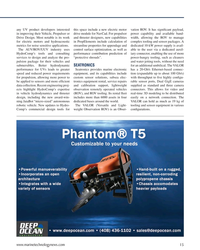 )
September 2022 - Marine Technology Reporter page: 15
)
September 2022 - Marine Technology Reporter page: 15interested this space include a new electric motor vation ROV. It has signi? cant payload, in improving their Vehicle, Propulsor or drive module for NavCad. For propulsor power capability and available band- Drive Design. Most notable is its work and thruster designers, new capabilities width, allowing
-
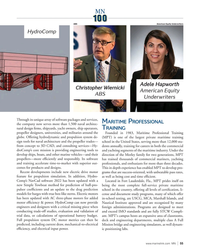 )
October 2022 - Marine News page: 55
)
October 2022 - Marine News page: 55success-oriented, with unbeatable pass rates, feature for propulsion simulation. In addition, Hydro- as well as being cost and time ef? cient. Comp’s NavCad software 2022 has been updated with a Located in Fort Lauderdale, Fla., MPT prides itself on new Simple Towboat method for prediction of hull-pro-
-
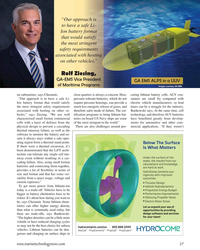 )
July 2022 - Marine Technology Reporter page: 37
)
July 2022 - Marine Technology Reporter page: 37charging cycles so may not be the best choice for subsea hydrocompinc.com/uv 603.868.3344• ® ® ® ® vehicles. Lithium batteries can be dan- NavCad PropElements PropCad PropExpert• • • gerous and charging on surface ships in www.marinetechnologynews.com 37 MTR #5 (34-49).indd 37 6/30/2022
-
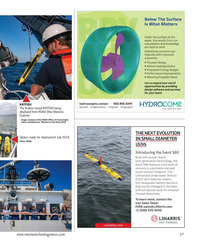 )
September 2020 - Marine Technology Reporter page: 37
)
September 2020 - Marine Technology Reporter page: 37of opportunities by providing design software and services for your team! U VU AU U U VU V hydrocompinc.com/uv 603.868.3344L KATFISH ® ® ® ® NavCad PropElements PropCad PropExpertL L L The Kraken towed KATFISH being Your Ideas. Our Tools. deployed from NOAA Ship Okeanos Explorer. Image
-
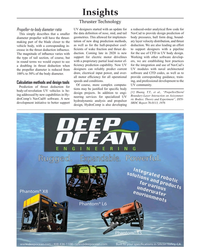 )
September 2020 - Marine Technology Reporter page: 19
)
September 2020 - Marine Technology Reporter page: 19analytical ? ow code for Propeller-to-body diameter ratio This simply describes that a smaller the data de? nition of nose, mid, and tail NavCad to provide design prediction of geometries. This allowed for implemen- body pressures, hull form drag, bound- diameter propeller will have the thrust- maki
-
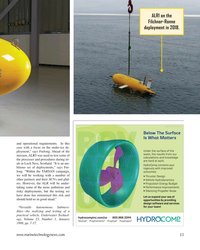 )
January 2022 - Marine Technology Reporter page: 33
)
January 2022 - Marine Technology Reporter page: 33realizing and testing of a practical vehicle. Underwater Technol- hydrocompinc.com/uv 603.868.3344• ogy, Volume 23, Number 1, January ® ® ® ® NavCad PropElements PropCad PropExpert• • • 1998, pp. 7-17. www.marinetechnologynews.com 33 MTR #1 (18-33).indd 33 1/25/2022 10:07:22 A
-
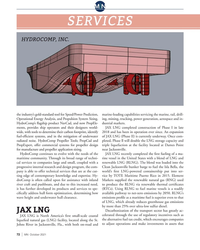 )
October 2021 - Marine News page: 72
)
October 2021 - Marine News page: 72drill- Operational Energy Analysis, and Propulsion System Sizing. ing, mining, trucking, power generation, aerospace and in- HydroComp’s ? agship product NavCad, and now PropEle- dustrial markets. ments, provides ship operators and their designers world- JAX LNG completed construction of Phase I in late wide
-
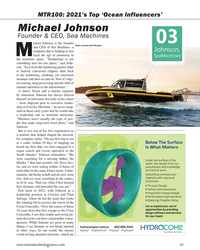 )
September 2021 - Marine Technology Reporter page: 41
)
September 2021 - Marine Technology Reporter page: 41catastrophic conse- quences. While humans are great at many things, I see humans as not being optimal hydrocompinc.com/uv 603.868.3344L ® ® ® ® NavCad PropElements PropCad PropExpertL L L in other ways. In our world, the marine Your Ideas. Our Tools. world of long duration missions, which
-
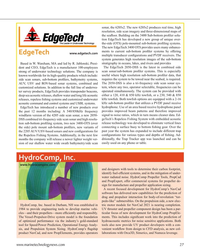 )
September 2021 - Marine Technology Reporter page: 27
)
September 2021 - Marine Technology Reporter page: 27PropExpert, offer commercial systems for propeller de- sign for manufacture and propeller application sizing. A recent focused development for HydroComp’s NavCad software has delivered new capabilities for the prediction of drag and propulsor interaction for body-of-revolution “tor- pedo-like” submersibles
-
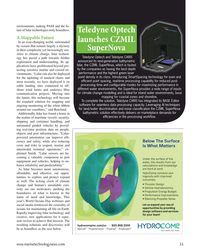 )
July 2021 - Marine Technology Reporter page: 35
)
July 2021 - Marine Technology Reporter page: 35for it repre- sent vectors to achieve that mission. The resulting solutions and discoveries will hydrocompinc.com/uv 603.868.3344L ® ® ® ® NavCad PropElements PropCad PropExpertL L L be as boundless as the seas below. Your Ideas. Our Tools. www.marinetechnologynews.com 35 MTR #5 (34-49)
-
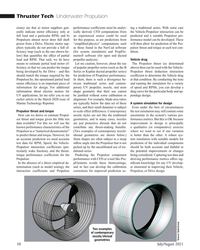 )
July 2021 - Marine Technology Reporter page: 10
)
July 2021 - Marine Technology Reporter page: 10sup- “simpli? ed-physics” computations such will then allow for prediction of the Pro- pliers typically do not provide a full ef- as those found in the NavCad software pulsor thrust and torque at each test con- ? ciency map (such as the one shown be- (for system simulation) and PropEle- dition. low) that
-
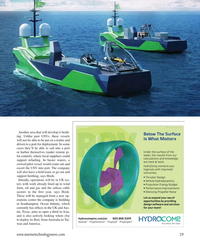 )
January 2021 - Marine Technology Reporter page: 29
)
January 2021 - Marine Technology Reporter page: 29a third in Asia, and is also actively looking where else hydrocompinc.com/uv 603.868.3344L to deploy its ? eet, from Australia to Tai- ® ® ® ® NavCad PropElements PropCad PropExpertL L L Your Ideas. Our Tools. wan and America. www.marinetechnologynews.com 29 MTR #1 (18-33).indd 29 1/25/2021
-
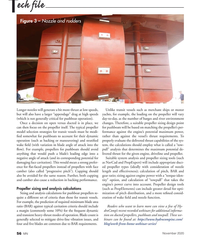 )
November 2020 - Marine News page: 56
)
November 2020 - Marine News page: 56its corresponding potential for Suitable system analysis and propeller sizing tools (such damaging face cavitation). This would mean a strong prefer- as NavCad and PropExpert) will include appropriate duct- ence for ? at-faced propellers instead of propellers with face ed propeller types (ideally with considerati
